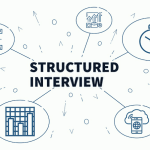Interviews are data collection instruments involving a face-to-face interaction in which oral questions are posed by an interviewer to draw out responses from the interviewee. An interview of whatever type involves direct personal contact with the participant who is asked to answer questions.
Interviews are basically in two types. These are the face-to-face interview and the telephone interview. You have to note that whether it is face-to-face of telephone interview you are using, they have the same characteristics. The only difference between face-to-face and telephone interview is that in telephone interview no one sees the other. The advantages of the telephone interview are that it is cheaper, especially if the respondents are very far away, and the interviewee is shielded from the influence of the interviewer. Interviews can also be classified in the following categories:
Unstructured Interviews
In this approach to interviewing, the researcher has some idea in mind of the topics to be covered and may use some sort of topic list as a reminder. There is minimal control over the order in which topics are covered and over respondents’ answers. In unstructured interviewing, neither the specific questions to be asked nor the range or type of possible answers are pre-defined. They are informal and conversational.
The aim is to get the informants to open up, and the researcher should stimulate an informant to produce more information. This approach allows the interviewer to be responsive to individual differences and situational characteristics. This approach builds on observation. It is useful in studying sensitive topics such as sexuality or political topics. To effectively achieve the aims of an open-ended interview, one must ask a whole series of secondary questions such as:
- What do I want to get out of these interviews?
- With whom am I going to conduct these interviews?
- How do I know they will talk to me?
- How many interviews must I do?
As much as possible, test your methods in advance. Because there is no set format for conducting these interviews, each interview is unique. This makes it difficult to systematise and analyse data.
Advantages
Unstructured interviews have the following advantages:
- They are flexible. This is because there are no pre-defined questions. This allows the respondents to freely respond to an issue. The researcher can therefore gather a lot of information.
- The respondent feels part of the team since no rigidity is displayed. He/she can therefore freely participate in the research.
- Since it is a free response in a relaxed atmosphere situation, the answer given are more reliable.
- It allows the interviewer to be responsive to individual differences and situational characteristics.
- This instrument is useful for studying sensitive topics such as sexuality and abortion.
Disadvantages
Unstructured interviews have the following disadvantages:
- They are time consuming since a respondent can dwell on one issue.
- They are not systematic as a respondent can comment on issues in a haphazard way. A respondent can comment on issues already discussed.
- If the researcher is not careful, it can get out of control, with the respondent getting too emotional or personal.
- Irrelevancies can be displayed by the respondent.
- Since there is no set format for conducting these interviews, it is difficult to systematise and analyse data.
Semi-structured Interviews
These interviews are based on the use of an interview guide. This is a written list of questions or topics that need to be covered by the interview. There are several types of semi-structured interviews.
- Focused interviews – This intensively investigates a particular topic. They aim at gaining a complete and detailed understanding of the topic.
- Case studies – The purpose of case studies is to collect comprehensive, systematic and in-depth information about particular cases of interest.
Advantages
Semi-structured interviews have the following advantages:
- They are flexible. This is because they consist of both open and closed-ended questions.
- In-depth information is gathered by closed ended questions.
- By using both the open and closed-ended approach, the researcher gets a complete and detailed understanding of the issue under research.
Disadvantages
Semi-structured interviews have the following disadvantages:
- They can be time consuming due to the open-ended questions.
- Analysis of data may be problematic.
- The respondent may be cautious of the answers given in close- ended questions.
Structured Interviews
These involve subjecting every informant in a sample to the same stimuli, for instance, asking each informant similar questions, as in the case of a survey.
Advantages
Structured interviews have the following advantages:
- The reliability of the information gathered is high. This is because each informant is subjected to similar questions with the others.
- It gives in-depth information about particular cases of interest to the researcher. This is because the researcher seeks information on specific issues.
- It is systematic. Researchers intensively investigate a particular issue before moving to the next.
- It is time-saving since the respondents simply answer what has been asked by the researcher.
- The researcher gets a complete and detailed understanding of the issue from the respondent.
- It is comprehensive and systematic since questions are formulated before the interview.
- The data collected is quantifiable.
Disadvantages
Structured interviews portray the following disadvantages:
- The rigidity displayed by the researcher can affect the responses given. The respondent may feel as if he/she is under investigation and is being probed. This may affect the response. Some of the respondents may become hostile.
- It is too formal. Since the researcher does the questioning and the respondent simply answers, the respondent may be too cautious in the answer given. The respondent may give answers he/she thinks are acceptable or will impress the researcher.
- The researcher may miss out on some important points that are not included in the questions formulated.

